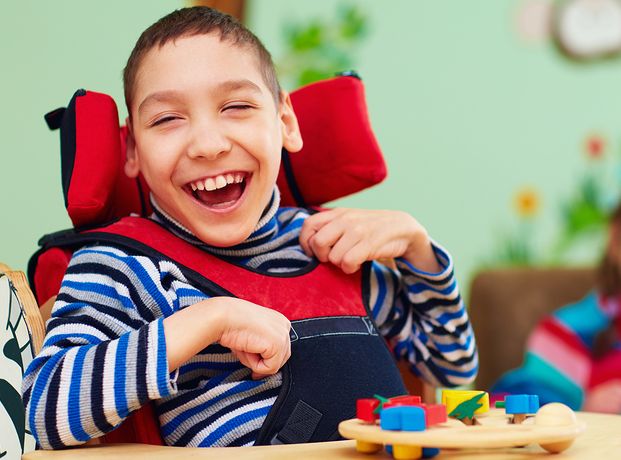Cerebral Palsy (CP) is a disabling physical condition in which muscle coordination is impaired due to damage to the brain. It occurs at or before child birth. Cerebral Palsy is not a progressive condition; meaning it does not get worse with time. However, muscle disuse could increase the extent of disability over the period of time. At present there is no cure available for this condition. Thus, Cerebral Palsy is incurable and life-long condition, at present.
CP is one of the most prevalent childhood disabilities. According to Dr. Edwin Dias, 3 out of every 1000 babies suffer with Cerebral Palsy in India. Prevalence of CP is same in the United States as well. In Australia, 1 in every 700 babies is diagnosed with CP.
Cerebral Palsy can cause locomotor disability i.e. it can hamper voluntary movement of muscles. Locomotor disability can range from muscular weakness to complete lack of movement in muscles. People affected with CP are also likely to have other types of impairment.
Meaning of Cerebral Palsy
The word “Cerebral” refers to Cerebellum — the brain part that usually gets damaged in CP. “Palsy” refers to the resulting movement disorder.
Meaning of Cerebral Palsy in Hindi
In Hindi language, Cerebral Palsy is called mastishka pakshaghat ( मस्तिष्क पक्षाघात ). This meaning in Hindi refers to the fact that about 40% people affected with CP have hemiplegia (i.e. one half of the body has difficulty in movement).
Types of Cerebral Palsy
This is important to note that Cerebral Palsy is a general term used for a group of disorders that affect a person’s motion, balance, and posture because of brain damage at or before birth. There are four main types of Cerebral Palsy:
- Spastic Cerebral Palsy: This is the most common type of CP. It affects more than 70% of CP patients. Spastic CP causes muscle rigidity and affected people struggle to control their movements, eat and speak.
- Athetoid Cerebral Palsy: About 10-20% CP patients have Athetoid CP. It is characterized by involuntary jerky movements of the arms, legs, hands and feet.
- Ataxic Cerebral Palsy: Close to 10% CP affected people have ataxic CP. They feel tremors while making voluntary movements. Because of tremors, people with Ataxic CP find it difficult to do tasks that require precise movement of muscles.
- Mixed Cerebral Palsy: Those people who have symptoms of more than one type of CP, are categorized under mixed CP.

Cerebral Palsy ICD-10 Codes
International Classification of Diseases, Tenth Revision, Clinical Modification (ICD-10 CM) is an internationally accepted classification system of various human diseases. A specific ICD-10 code identifies each type of disease. The ICD-10 code for Cerebral Palsy is G80. Here are the ICD-10 codes for various types of Cerebral Palsy:
- G80 Cerebral palsy
- G80.0 Spastic quadriplegic cerebral palsy
- G80.1 Spastic diplegic cerebral palsy
- G80.2 Spastic hemiplegic cerebral palsy
- G80.3 Athetoid cerebral palsy
- G80.4 Ataxic cerebral palsy
- G80.8 Other cerebral palsy
- G80.9 Cerebral palsy, unspecified
Facts about CP
- Cerebral palsy is a lifelong disability.
- Disability may increase with age, and ageing may occur earlier.
- Predictions of severity are most accurate at 2 years of age.
- Without rehabilitation and orthopedic management, a person with cerebral palsy can deteriorate physically.
Cerebral Palsy in India
According to Indian Institute of Cerebral Palsy, about 33,000 CP affected people in India.
CP in RPWD Act 2016
Cerebral Palsy has been included as a government recognized disability in India’s Rights of Persons with Disabilities Act (RPWD) 2016.
If you have more information to add to this article, please add it in comments section. Please share your experiences if you’re affected with CP or if you’re caring for a CP affected person. Sharing information is very important in dealing with disabilities. Thank you for connecting with WeCapable!
Use the citation below to add this article to your bibliography
"Cerebral Palsy: Meaning, Types, Prevalence, Symptoms." Wecapable.com. Web. July 27, 2024. <https://wecapable.com/cerebral-palsy/>
Wecapable.com, "Cerebral Palsy: Meaning, Types, Prevalence, Symptoms." Accessed July 27, 2024. https://wecapable.com/cerebral-palsy/
"Cerebral Palsy: Meaning, Types, Prevalence, Symptoms." (n.d.). Wecapable.com. Retrieved July 27, 2024 from https://wecapable.com/cerebral-palsy/

My mother’s twin has CP, but we don’t have any documentation. Where can we visit in Delhi for a ceritfication? He is 48 years old, on wheel chair and cannot speak properly
my son devershee sachan having locometer disability (cerebral palsy).he can not walk ,his hand can not grap any object properly.his eyes are very low vision and turn eye bowl many time.He is 24 year old ,he pursuing beachlor of Design from anasl university,india,
His mental health is week he can not study long time ,his petient level going very high and his anger can not control easily..his diaghragm very week and his lungs effected by sever neumonia.his breathing level very low.his palm has no muscle power.
Good thing for his life ,He is para athelete participent para Asian Championship 2018 in jakarata.His national level performance is very good every time he won with gold medal.He is Redcross life member and State awrdee from Indian Redcross Society.devershee won many awards and appreciation certificate foe his social work.in covid 19 pendemics he is doing work for welfare of slum and needy people .serving food ,mask and senetizer to them,devershee sachan very good motivational speaker and his presence for slum school childrens highly appreciable.
Reagrds
Kalyani sachan (mother of devershee sachan)
9810981687
Mentioning as Cerebral Palsy in disability certificate will affect employment opportunities ? Please clarify…
No. There will not be any effect.
If disability certificate shows 80% cerebral palsy in a child, is it effective for getting govt job?
Such a certificate will entitle the person to get reservation under disability quota. However, there is no guarantee that the person will get a government job.